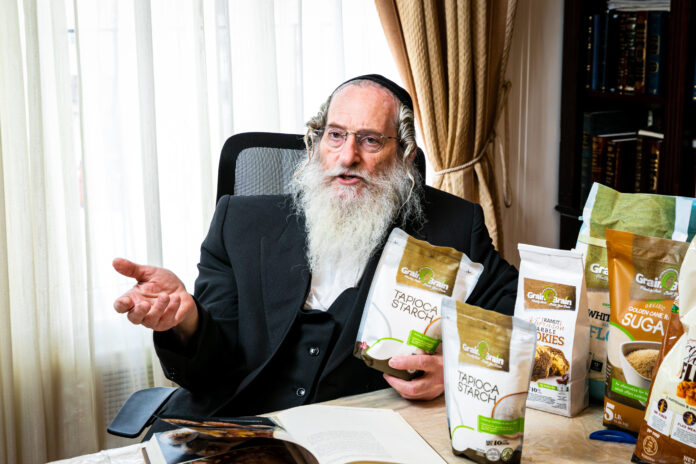Let’s face it, it can be very difficult to earn enough income to support a growing family. As children become older and celebrate milestones, the financial burden can be crushing. Facing these financial obligations in the middle stages of life could keep someone from starting a new job or launching a new business. After all, if you’re in your 40s or 50s, isn’t it too late to start over? But Reb Shloma Efraim Sandel proves the opposite.
Reb Shloma Efraim was a rebbi for over 30 years and to this day gives shiurim in how to lead a classroom. He started his very first business when he was close to 50 years old.
Confronted with the high costs involved in marrying off his first two children, Reb Shloma Efraim took a lifelong passion for healthy eating and turned it into a flourishing business named Grain Brain. Grain Brain focuses on bringing organic, healthy flours and other baking items to the kosher market.
Starting as a one-man show, Reb Shloma Efraim put in many years of “sweat equity” to build his business. Today, he runs Grain Brain with two of his sons, Moshe and Eluzer.
In our conversation, we discussed what it was like starting anew at an age at which most people hope to be financially settled. I asked Reb Shloma Efraim what chizzuk he would give to someone hoping for sunnier days, and he spoke from the heart. His message is strong yet simple: Don’t forget about Hashem, and just keep going.
—Nesanel
“I was born in Brooklyn, New York. Both of my parents are from Europe. My father, Reb Avrohom Sandel, was from Kashau, and my mother was from Hungary. My mother was the sixth generation from the Sar Shalom of Belz and Rav Shimon Yaroslaver.
“My father had an interesting career when he came to America: he made yarmulkes. In fact, he made all the yarmulkes for the Satmar Rebbe, Rav Yoel, from when the Rebbe came to the US. Later, my father went into real estate, and in 1970, he opened his company Salko Kitchens, which one of my brothers runs today.
“I am the middle of 13 children and, interestingly, Hashem has bentched me with 13 children as well.
“I went to Satmar Yeshivah for cheder and beis midrash, though I also learned in Tosh for a few years, where I developed a relationship with the Tosher Rebbe.
“I can’t say I was very business-minded as a teenager, but I was pretty creative. For example, I created Sukkah decorations, including elaborate setups for the Satmar sukkah, which the Rebbe liked very much. I remember making an intricate Ushpizin display one year.
“When I was a teenager, I had an idea to create a collection of all the existing recordings of the Satmar Rebbe. Many people had recordings of him giving shiurim, but they were individual recordings made by individual people. I bought a cassette duplicator, made copies of all the recordings I could get my hands on, and sold them. I had many interesting recordings, including the Rebbe’s Shalosh Seudos Torah, Chanukah Torah, Hoshana Rabbah, and the Rebbe’s talks at the Satmar dinners. My brother Shulem, who has been setting up PA systems for many years, also recorded several of the Rebbe’s shiurim.
“My love for the Rebbe comes from my father. He had a close relationship with the Rebbe, and he also had a real eimah, a fear of the holiness of the Rebbe.
“My father knew the Satmar Rebbe from when he was a bachur before the war. One Shabbos, the Rebbe was in a small shtetl near Kashau. With my grandparents’ encouragement and permission, my father’s maggid shiur took my father with him for Shabbos to see the Rebbe as a reward for learning so well in yeshivah. My father remembers how the Rebbe sang Shalom Aleichem, and that’s the niggun I grew up with.
“He davened with the Rebbe every Shabbos, and he brought me to the Rebbe’s Kiddush from when I was a young boy. The Rebbe passed away on a Sunday, and I was with him that last Shabbos.
“My father loved having a connection to tzaddikim. The Satmar Rebbe was his rebbe, but he was also close with the Tosher Rebbe; the Stropkover Rebbe, Rav Menachem Mendel; and the Shoproner Rav, Rav Shimon Yisroel Posen.
“My mother was a gifted seamstress, and she made all of her own clothing as well as my sisters’ clothing. She also made clothes for the Satmar Rebbetzin and hand-sewn cloth shoes for the Rebbe, which he wore on Yom Kippur and Tishah B’Av.
“Both my parents passed away about three years ago, within ten months of each other.
“I learned in Satmar until age 13. I then learned in the Paya Yeshivah for a year, and then in Tosh until I was 17, at which time I went back to Satmar until my wedding.
“I would go back to Tosh at least once a year to spend Shabbos with the Rebbe. I’ll share with you an interesting story about the Tosher Rebbe. When I was a bachur in yeshivah, one of my brothers got engaged and I wanted to go home that Shabbos to be with my family to celebrate. The Rebbe said to me, ‘You probably want an aliyah for Shabbos. Stay in yeshivah and I’ll give you an aliyah.’
“I told the Rebbe that I still wanted to go home. He said, ‘Stay and eat by me.’ That didn’t persuade me, either. The Rebbe said, ‘I’ll give you a double portion.’ Finally, he said, ‘You can stay in my home.’ I realized that it was very important to him that I stay, so I stayed. I remained close with the Tosher Rebbe ever since.
“After my wedding, I learned in kollel for a few years until I got my first job as a melamed at the Shopron cheder, where I taught for five years. In 1984, I became a rebbi in Monroe, where I taught kitah vav. I stayed there for the next 25 years.
“Although I am no longer an active rebbi, I have very fond memories of it. I really enjoyed working with the children and seeing them grow. Although there are many aspects to being a good rebbi, if I had to pick one thing I was good at, it would be showing the children that I believed they could succeed.
“I recall one child who came to my class after the yeshivah told his father that he would do better in a certain yeshivah that catered to children with real learning disabilities. I asked them to wait until the end of the year before making a decision. Well, he never went to that yeshivah. He has done well in life, and baruch Hashem, today he is married with a child.
“In 1990, I was zocheh to start the Chevras Tehillim in Kiryas Yoel. Every Erev Shabbos, children gathered in shul to say Tehillim, and we gave out candies and refreshments to encourage them. We started with a handful of boys and quickly went to 120 and then 400. The program spread throughout Kiryas Yoel, and today it is a standard program in hundreds of shuls across the world, baruch Hashem.
“In Chevras Tehillim, we had boys from a very young age until bar mitzvah. I realized that the young children had a hard time saying Tehillim, and I thought that one reason might be because there really weren’t any Tehillims out there that were clear and easy to read. When they are first learning to read, it’s much harder if the font isn’t clear. I paid $5,000 for a Tehillim text that was considered mugah, meaning that it was checked for mistakes and based on the earliest mesorah. When I got the text, I had it checked again and upgraded, which cost me $10,000. I worked with an artist to create a clear font, and we produced the Tehillim Hamugah. The children were able to read it much more easily, and it has since sold over 100,000 copies.
“Rav Hershele of Spinka, zt”l, gave me his haskamah for the Chevras Tehillim in an interesting way. I went to see him, and believe it or not, he stood up for me. He said, ‘You are like Dovid Hamelech because you help spread Tehillim among klal Yisrael.’ That encouraged me to keep on going with the program.
“Many years ago, I met Rav Yaakov Meir Schechter and we had a deep conversation with Rav Hershele about melamdus and chinuch. He encouraged me to translate Chovos Halevavos into Yiddish, along with added stories and lessons in emunah and bitachon. I have been working on this sefer for close to 40 years, and baruch Hashem, it’s almost ready for publication.
“I also published a sefer on brachos with the encouragement of Rav Schechter. It’s called Vaavarchah Mevarachecha. It’s written in Yiddish and discusses the power of making 100 brachos a day, saying amein and yehei shmei rabbah, Krias Shema and more. I also published a version in lashon hakodesh called Bni Barcheini. It took me six years to write, and it’s been used as part of the curriculum in many yeshivos.
“The Satmar Rebbe once held a gathering of melamdim, and he was asked for advice on what makes someone a solid rebbi. The Rebbe said, ‘Al shloshah devarim hamelamed omeid: he has to know the curriculum very well, he has to be able to give it over to the talmidim, and he needs to have proper control over his class. Im shlosh eileh lo yaaseh lah, v’yatz’ah chinam ein kasef—if he doesn’t have these three things, then he needs to look for another line of work.’ I’m not a big talmid chacham, but at least I was given the koach of hasbarah.
“I enjoyed being a melamed, and all was well until I started marrying off my children. I married off a son and daughter in quick succession, and it cost a lot of money. For one of my children, I had to contribute towards an apartment as well as the wedding, and I went into debt. That was when I quit being a melamed. When I quit, it wasn’t so that I could get a higher-paying job somewhere else, although I knew I needed to do that. The main reason I quit was that I felt I was not in the right state of mind to be a proper rebbi, because I had so many chovos. I didn’t think it was fair to my talmidim. For one year, I didn’t work. I tried to figure out how I could make a living.
To read more, subscribe to Ami





















